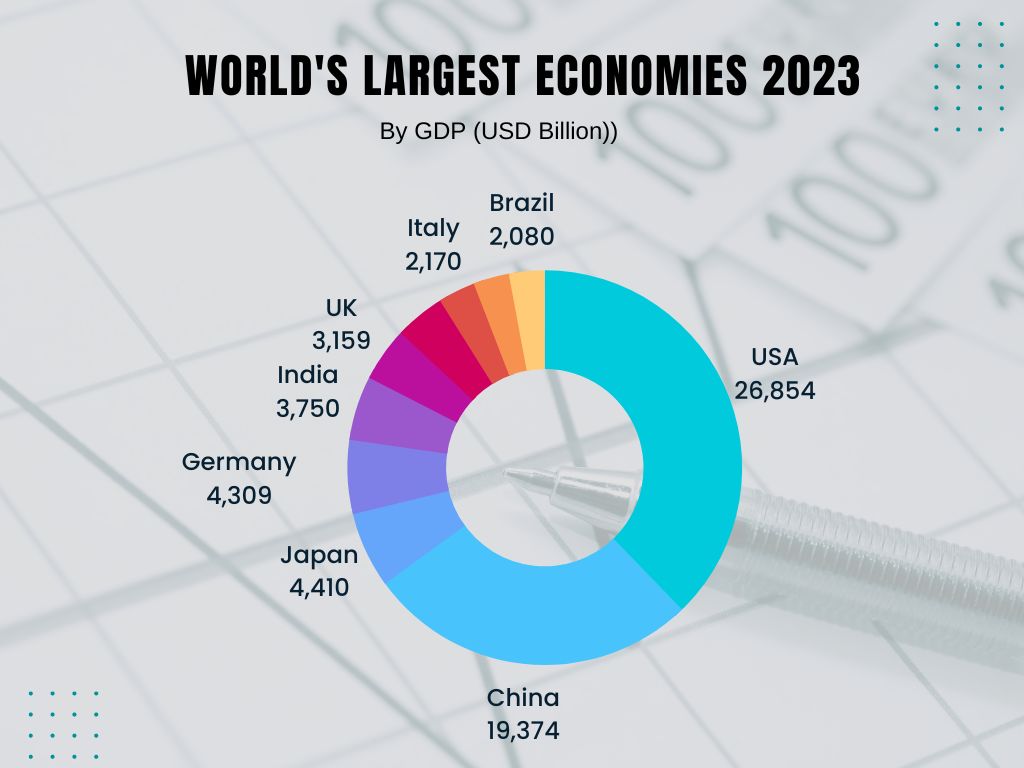India to surpass US as 2nd-largest economy by 2075? Here’s how

Goldman Sachs, an investment banking firm, in a research report forecasts that with India's population crossing 1.4 billion (140 crores), the country maintains a favourable working-age population to children and elderly ratio, positioning it for economic growth. Moreover, the dependency ratio is expected to stay among the lowest in the next two decades.
Santanu Sengupta, India economist at the firm also commented on the report saying, “So that really is the window for India to get it right in terms of setting up manufacturing capacity, continuing to grow services, continuing the growth of infrastructure.”

World’s biggest economies 2023: An Overview
Currently, India holds the fifth position among the world's leading economies, with a GDP of US$ 3,750 billion. The United States secures the top position with a GDP of US$ 26,854 billion, followed by China at the second rank with a GDP of US$ 19,374 billion, and Japan at the third rank with a GDP of US$ 4,410 billion. Here is a look at the top 10 largest economies in the world as of 2023:

Challenges in India’s economic growth
The research analysis also outlined the following challenges hampering India’s economic growth:
- While India's large workforce presents opportunities, there is a challenge concerning the labour participation rate.
- Over the past 15 years, the labour participation rate has declined, specifically among women who have significantly lower participation compared to men.
Santanu remarked, “Net exports have always been a drag on growth because India runs a current account deficit. In recent times, we are seeing some progress on that front. Services exports have been increasing, and that is somewhat cushioning current account balances.”
To improve the workforce participation rate (including women), India needs to work on the following recommendations:
- Generate employment opportunities
- Introduce training and upskilling programs
The study revealed that with an improved labour force participation rate, India’s potential to enhance economic growth will also escalate.
Key factors for enhancing India's economic growth

In addition to the favourable demographics, the research also highlighted the following key drivers to boost the Indian economy:
- Innovation
- Capital investments
- Infrastructure development
- Scaling up manufacturing and services in the private sector
- The transition towards green energy
Santanu said, “On this front, the government has done the heavy lifting in the recent past. But given the healthy balance sheets of private corporates and banks in India, we believe that the conditions are conducive for a private sector capex cycle. There’s a lot of infrastructure creation that is going on now, primarily led by the government’s focus on setting up infrastructure in terms of roads, railways and so forth. We believe this is also the appropriate time for the private sector to scale up on creating capacities in both manufacturing and services which has the potential of creating jobs and absorbing the large labour force.”
He also notified the country’s net exports and commodity prices as the key factors to decode the Indian economy.
So far, India's growth is driven by domestic demand, but the current account remains in deficit. India’s dependence on importing most of the commodities results in macro imbalances. However, there have been recent improvements in the macro environment, including the growth of service exports and the implementation of inflation targeting, which have provided some support.
Harnessing green energy for India's economic growth
The research also emphasised the role of green energy in a country’s economic growth. It stated India has ambitious targets of achieving:
- Net-zero emissions by 2070,
- Generating 50% of power from non-fossil sources by 2030,
- Prioritising electric vehicles and green hydrogen.
While transitioning to green energy offers substantial investment prospects, India's reliance on fossil fuels will endure until the transition is fully realised. The country's green energy ambitions align with global sustainability objectives, creating opportunities for growth and innovation in the energy sector.
Santanu concluded the report by stating, “Transitioning to green energy is a large investment opportunity, but it’ll take time. In the interim fossil fuels are going to be the majority share in energy needs until India transitions to green energy,”









